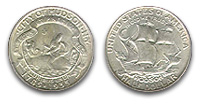Coins that are relatively worthless may appear intriguing and possibly valuable to the untrained eye. But they’re of little interest to experienced coin collectors. And novice collectors often overpay for them.
Fakes are even more dangerous. They’re not always completely valueless, but they’re undoubtedly worth less than their asking price. It’s no wonder that novice hobbyists are often deceived.
Even the most experienced coin collector may have trouble detecting some fakes.


For instance, in 1922 the Denver mint accidentally produced a few pennies without a D (for Denver), which can be worth thousands of dollars. Counterfeiters have altered pennies minted with the D by filing the D off, hoping to make them more valuable. It’s hard to discern a real penny that’s missing the D from a fake one.
Fake pennies dated 1793


Halperin works for Heritage Numismatic Auctions in Dallas. He suggests protecting yourself by buying from a member of the Professional Numismatics Guild or having expensive coins authenticated by the Professional Coin Grading Service or the Numismatic Guarantee Corporation.
Authentic 1785 coins from the city of Hudson, New York
The American Numismatics Association Certification Service usually has a booth at coin shows where numismatic experts will give you a free opinion on the authenticity of a coin.
Here are a few of the more common fakes:
1804 dollars
Authentic 1804 dollars are very rare. Sometimes the dates of more common dollars from 1800 through 1803 are altered to look like 1804s. Other fakes are cast copies, made in a mold. Genuine examples of this coin, made by stamping a piece of metal, are worth from $500,000 to $4,000,000 each.
Electrotypes of rare colonial coins
Electrotype copies of Massachusetts silver coins, Nova Contellatio Pattern coins, Bar cents, and Confederatio coppers are all fairly common. They’re worth no more than $100, but the original coins are worth thousands or even tens of thousands of dollars.
Electrotype fakes are lead-filled copies of earlier coins. They’re identified by faint seams around their edges or minute traces of lead seeping through the surface. Also, electrotypes make a different sound than real coins when dropped on a flat, hard surface.
Pioneer gold coin replicas
These fakes rarely fool seasoned collectors or dealers. They were sold extensively during the 1950s and 1960s and even came in cereal boxes.
Copper-plated 1943 cents
1943 copper cents are worth $10,000 to $100,000. Many 1943 steel cents, worth $.05, have been copper-plated to look like the valuable ones. 1948 copper cents are also occasionally altered to mimic 1943 cents.
Before taking a suspect 1943 cent to an expert, pass a magnet over it. The magnet will pick up a copper-plated steel coin, but not a genuine 1943 copper cent. Also check the date. On a real cent, the bottom loop of the three will extend below the rest of the date.
Double sided coins
Magicians often use coins that have two heads or two tails made by putting two halves of two coins together. Sometimes they accidentally make their way into circulation, because they’re the same size and weight as real coins. However, they’re nearly impossible to make by accident. Real coins are stamped on both sides at the same time.
Fake coins are counterfeit or fraudulent coins that are created with the intent to deceive and pass off as genuine currency. Counterfeit coins can be made from a variety of materials, including base metals or alloys, and are often designed to closely resemble legitimate coins in terms of size, weight, and appearance.
Counterfeit coins
If you suspect that you have encountered a fake coin or if you want to verify the authenticity of a coin, it’s advisable to consult with a numismatic expert, coin dealer, or a professional coin-grading service. These experts can examine the coin and use their knowledge and equipment to determine whether it is genuine or counterfeit.
Producing, distributing, or using counterfeit currency, including coins, is illegal in most countries and can result in serious legal consequences. If you come across counterfeit coins or believe you have unknowingly received one, it’s important to report it to the relevant authorities to prevent its circulation and help with the enforcement of anti-counterfeiting laws.
Further Reading:
2002 Guide to U.S. Coins: Prices and Value Trends by William Gibbs
The Insider’s Guide to U.S. Coin Values 2002 by Scott Travers
The Whitman Coin Guide to Coin Collecting by Kenneth Bressett
Coin Collector’s Price Guide by Robert Obojski
2001 Guide to U.S. Coins, Prices, & Value Trends by William Gibbs
Related stories
Police Ephemera ° The value of Victorian reward posters
Our Numismatic coin and bank note feature stories are here





